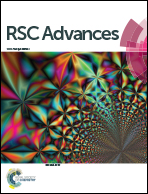Copolymerization of Eu(TTA)3Phen doped styrene and methyl methacrylate nanoparticles and use in quantitative detection of pepsinogen
Abstract
High fluorescence intensity nanoparticles were prepared by copolymerization of Eu(TTA)3Phen doped styrene and methyl methacrylate. The fluorescent nanoparticles were used as labels for the quantitative detection of serum pepsinogens. Anti-pepsinogen I antibodies and anti-pepsinogen II antibodies were coated on the nitrocellulose membrane as test line 1 and test line 2 respectively. Serum pepsinogen I and pepsinogen II were detected simultaneously in one strip through sandwich immunoassay. This immunoassay strip can analyze the serum pepsinogens in one step and obtain results within 15 minutes. The limit of detection of this immunoassay strip for PG I and PG II standard analytes was 0.5 ng mL−1. The reproducibility and recovery tests shows that the quantitative results were accurate, and the strip can be used in clinical applications.



 Please wait while we load your content...
Please wait while we load your content...